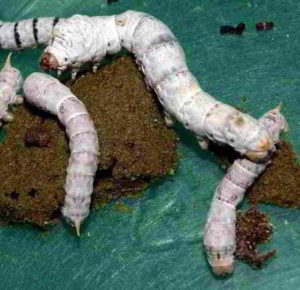Silkworms – an awesome food

Silkworms are a nutritious reptile food, with a high calcium to phosphorous ratio and excellent protein and vitamin content.
Silkworms are the caterpillar of the Bombyx mori. This is a smallish moth reared commercially in huge numbers for its silk cocoons; it is no longer found in the wild and is totally domesticated.
Some pet shops occasionally stock silkworms and in early spring large numbers appear as the eggs from the previous year hatch but once that initial flush has passed they tend to disappear. This is a shame as they are very easy to rear throughout the year. Most of the cultures available in South Africa are univoltine, meaning that they have only one natural brood a year. To keep them growing throughout the year it is necessary to break that annual cycle.
Silkworms all year long!
To do this we use the following process:
- Allow the moth to lay her eggs, preferably in a small paper lined tub to avoid her laying them on the cocoon.
- Leave the eggs until they go dark grey or for about 3 weeks at room temperature.
- Then put the eggs in a plastic box, making sure that it is dry, in the fridge for 14 weeks. This is the length needed, in our experience, to break the diapause or hibernation.
- After 14 weeks take out as many eggs as needed, leaving the rest in the fridge. Put the removed eggs in a small plastic box and wait for 7 to 9 days when the eggs will hatch.
- As often as you need larvae take out eggs from the fridge and about a week later you will have hatchling silkworms.
- The eggs should continue to be viable in the fridge for a year or more.
Feed the larvae either mulberry leaves or artificial silkworm food. Lettuce, Beetroot etc will not keep your silkworms alive and they will eventually die. After growing for 4 to 6 weeks the silkworms will spin a silk cocoon and roughly 4 weeks later moths will hatch and mate, with the whole cycle starting over.
To learn more about how to breed these and other insects as food for your chameleon, check out this book: Breeding Insects as feeder food
